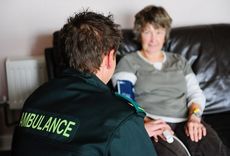Ambulance Clinical Quality Indicators
Ambulance Clinical Quality Indicators
All ambulance services in England are measured by, and report against, the Ambulance Clinical Quality Indicators (ACQIs) shown below. ACQIs were introduced in April 2011 for all UK ambulance services in England and look at the quality of care provided as well as the speed of response to patients.

This allows a comparison of our data with that of other ambulance services in the country.
Briefly, these ACQIs are:
Return of Spontaneous Circulation (ROSC) following an out-of-hospital Cardiac Arrest
This indicator monitors the number of patients who suffer an out-of-hospital cardiac arrest (heart stopped), and who are subsequently resuscitated and the heart restarts prior to their arrival at hospital.
Out-of-hospital Cardiac Arrest Survival to Discharge (30 days)
The number of patients Discharged or Transferred from hospital alive after 30 days after they have had an out-of-hospital cardiac arrest.
POST ROSC Management
Introduced in 2018, any patient who has a ROSC following an out-of-hospital Cardiac Arrest lasting for more than 10 minutes will receive a nationally recognised POST ROSC Care Bundle ensuring appropriate ongoing patient care until arrival at hospital.
ST-elevation myocardial infarction (STEMI)
ST-elevation myocardial infarction is a type of heart attack resulting from a blockage in a coronary artery. This monitors the number of patients who receive best practice care in the management of a heart attack. The gold standard treatment is primary angioplasty, carried out at a specialist (PPCI) centre. This is a procedure to insert a stent (plastic bridge) into the artery to remove the blockage and keep the artery open, (Primary Angioplasty Balloon Inflation We report nationally on the proportion of patients receiving these treatments within the target timescales.
STEMI Timeliness
The target is measured against national ‘Mean Average’, ‘Median’ & ‘90th Percentile’ time from call to hospital arrival.
Management of Stroke
This requires ambulance services to measure the time it takes from the 999 call, to the time it takes those FAST positive stroke patients to arrive at a specialist stroke centre (HASU) Hyper Acute Stroke Unit, so that they can be rapidly assessed for treatment called thrombolysis.
Stroke Timeliness
STROKE FAST positive patients (assessed face to face) potentially eligible for stroke thrombolysis arriving HASU emergency call “Clock Start Time”. The target is measured against national ‘Mean Average’, ‘Median’ & ‘90th Percentile’ time from call to hospital arrival.
NEW ACQI – Older Adult (65 and over) falls; discharged at scene
Nationally recognised that falls are the leading cause of emergency calls in the over 65s and account for 10-25% of emergency ambulance responses each year for adults over the age of 65 years old, (EEAST 3,000 calls per month), a new national ACQI Care Bundle has been released by NHS England.
Falls patients are identified as one of the ambulance services highest reattendance patient cohort. Falls are associated with increased morbidity and mortality, therefore having an impact on quality of life, health, and healthcare costs.
Patients aged 65 years and over who have a fall below 2 metres, (less than 10 steps) Should receive a thorough examination to exclude missed traumatic injuries before being Discharged at Scene Safely.
Call abandonment rate
This indicator will ensure that we and other ambulance services are not having problems with people phoning 999 and not being able to get through
Time taken to answer calls
It equally important that if people/patients dial 999 that they get call answered quickly. This indicator will therefore measure how quickly all 999 calls that we receive get answered
Service experience
All ambulance services will need to demonstrate how they find out what people think of the service they offer (including the results of focus groups and interviews) and how we are acting on that information to continuously improve patient care
Ambulance response time
This measures the speed of all ambulance responses to a patient and is recorded as a mean target.
Full month-by-month details about ambulance quality indicators can be found on the NHS England website.
